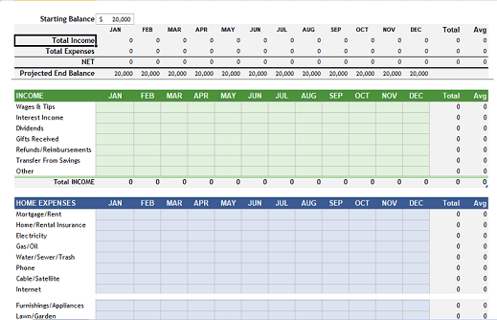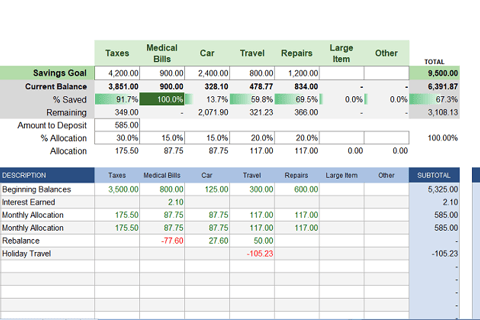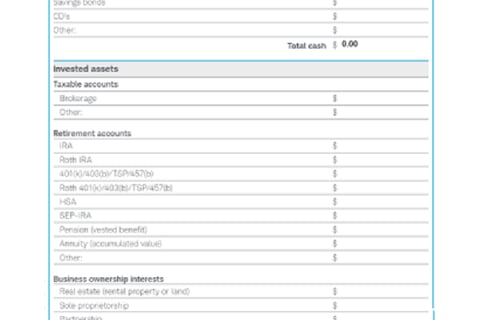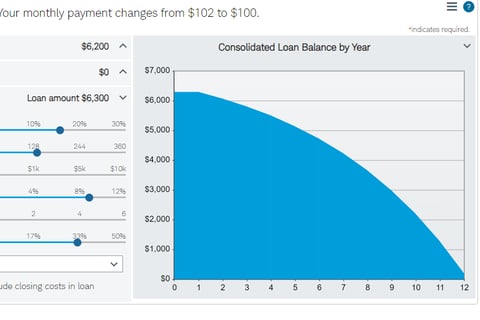Money Management Worksheets for Adults
Money Management Worksheets: A Comprehensive Guide for Adults for mastering their Finances
Money Management Worksheets for adults can be valuable tools to help individuals organize their finances, track expenses, set financial goals, and create budgets. These worksheets are designed to provide a clear overview of one's financial situation and promote responsible money management practices. Here are some key money management worksheets for adults.


Various money management worksheets for adults are described in detail below:
1. Personal Budget Worksheet: A personal budget worksheet for adults is a valuable tool that helps individuals track their income, expenses, and savings on a regular basis. It provides a comprehensive overview of one's financial situation, allowing them to understand where their money is going and make informed decisions about their spending and saving habits. Let's discuss the elements and benefits of a personal budget worksheet in detail:
Income: The first section of the worksheet captures all sources of income, including salary, wages, freelance earnings, rental income, and any other money coming in. This helps individuals understand their total monthly income and forms the basis for budgeting decisions.
Expenses: Individuals should mention all of their usual monthly spending in the expenses section. It covers basics like housing (rent/mortgage), utilities (electricity, water, gas), groceries, transportation (vehicle payments, petrol), insurance (health, auto, home), and other needs like minimum loan and credit card payments.
Discretionary Spending: This category includes any non-essential expenditures, such as dining out, entertainment, shopping, and vacations. Individuals might find areas where they might be able to make savings increases by tracking their discretionary spending.
Investments and Savings: The budget spreadsheet has an area for savings and investment. This is where people can set aside some of their income for things like emergency cash, retirement accounts (like 401(k)s and IRAs), and other investment products like stocks, bonds, or mutual funds.
Total Income vs. Total Expenses: A key element of the budget worksheet is calculating the difference between total income and total expenses. If the total expenses exceed the income, it indicates a budget deficit, which means adjustments are needed to avoid overspending.
Budget Goals: Personal budget worksheets often include a section for setting financial goals. This is where individuals can outline specific targets they want to achieve, such as paying off debts, saving for a down payment on a home, or funding a vacation.
Monthly Budget Variance: Tracking budget variance allows individuals to see how actual expenses compare to budgeted amounts. It helps in identifying any areas where spending may have exceeded the planned budget.
Benefits of a Personal Budget Worksheet:
Financial Awareness: The budget worksheet provides a clear picture of where money is going, fostering financial awareness and responsibility.
Decision-Making: With a budget worksheet, individuals can make informed decisions about spending, saving, and investing to align with their financial goals.
Identifying Areas for Improvement: The worksheet helps identify areas where expenses can be reduced to increase savings or pay off debts faster.
Goal Setting: Budget worksheets facilitate setting realistic financial goals and monitoring progress towards achieving them.
Avoiding Debt and Overspending: By tracking expenses and income, individuals can avoid accumulating unnecessary debt and stay within their means.
Planning for the Future: Budgeting allows individuals to allocate funds for future needs like retirement or emergency savings.
In conclusion, a personal budget worksheet is a powerful tool for adults to manage their finances effectively. It serves as a roadmap for financial success, helping individuals gain control over their money, make intentional financial decisions, and work towards achieving their financial aspirations.
2. Expense Tracker Worksheet: An expense tracker worksheet for adults is a useful tool that enables individuals to record and monitor their daily expenses systematically. It offers a comprehensive overview of spending habits, allowing individuals to gain insights into their financial behaviors and make informed decisions about their budgeting and saving practices. Let's delve into the elements and benefits of an expense tracker worksheet in detail:
Expense Categories: The worksheet typically includes predefined expense categories, such as groceries, utilities, transportation, housing, dining out, entertainment, healthcare, and other discretionary expenses. This categorization makes it easy to allocate expenses accurately.
Date and Description: Individuals record the date of each transaction and provide a brief description of the expense. This helps in identifying specific spending patterns and understanding the purpose of each expenditure.
Amount: The amount spent for each expense is noted, allowing for accurate tracking of total expenditures within each category.
Total Monthly Expenses: The expense tracker calculates the total expenses for each category and provides an overall total for all expenses during the month. This helps individuals understand their total monthly spending.
Comparison to Budget: By having a budgeted amount for each expense category, individuals can compare their actual spending against the budgeted amounts. This highlights any overages or areas where adjustments may be needed to stay within the budget.
Visual Representations: Some expense trackers include visual representations, such as charts or graphs, to provide a visual snapshot of spending patterns. These visuals make it easier to comprehend and analyze spending trends.
Benefits of an Expense Tracker Worksheet:
Financial Awareness: The expense tracker promotes awareness of where money is being spent, enabling individuals to recognize areas of overspending or unnecessary expenses.
Budget Compliance: By comparing actual expenses to the budget, individuals can assess their budget adherence and make necessary adjustments to align spending with financial goals.
Expense Reduction: Tracking expenses helps identify areas where individuals can cut back on spending, contributing to increased savings and debt reduction.
Accurate Financial Planning: The expense tracker provides data to create a more accurate budget for future months and allows for better financial planning.
Identifying Trends: Regular use of an expense tracker reveals spending patterns over time, empowering individuals to make meaningful changes in their financial behavior.
Goal Achievement: Monitoring expenses aids in achieving financial goals by ensuring resources are appropriately allocated and utilized.
Using an expense tracker worksheet helps individuals take control of their finances, practice responsible spending, and work towards their financial objectives. By consistently recording and analyzing expenses, individuals can optimize their money management, stay on top of their financial health, and make informed decisions that align with their long-term financial aspirations.
Savings Goal Worksheet: A savings goal worksheet for adults is a valuable tool that helps individuals set, track, and achieve their financial objectives. Whether it's building an emergency fund, saving for a vacation, funding a down payment on a home, or preparing for retirement, this worksheet enables individuals to create a clear roadmap for reaching their savings targets. Let's explore the elements and benefits of a savings goal worksheet in detail:
Goal Setting: The worksheet allows individuals to define specific and measurable savings goals. This includes setting a target amount and a target date by which they aim to achieve the goal.
Types of Goals: Savings goals can be short-term, medium-term, or long-term. The worksheet helps individuals differentiate between these goals and plan accordingly.
Current Savings: The worksheet provides space to record the current savings amount for each goal. This serves as a starting point for tracking progress.
Monthly Contribution: Individuals can determine how much they can contribute each month towards their savings goals. This amount is essential for calculating the time required to achieve the target.
Projected Completion Date: Based on the monthly contribution and the current savings amount, the worksheet calculates the projected completion date for each savings goal.
Savings Tracking: The worksheet allows individuals to track their savings progress regularly. This includes updating the current savings amount each month and observing how close they are to achieving their target.
Adjustment and Reallocation: As circumstances change, individuals can adjust their monthly contribution or reallocate savings towards more urgent goals. The worksheet helps in making these adjustments while maintaining overall financial discipline.
Celebrating Achievements: Successfully achieving savings goals is a reason to celebrate. The worksheet encourages individuals to acknowledge milestones and set new objectives for further financial growth.
Benefits of a Savings Goal Worksheet:
Clarity and Focus: The worksheet provides clarity by defining specific savings goals, helping individuals stay focused and committed to achieving them.
Motivation: Tracking progress towards savings goals boosts motivation, as individuals witness tangible evidence of their financial accomplishments.
Financial Planning: The worksheet facilitates effective financial planning, ensuring that individuals allocate funds wisely and align their resources with their priorities.
Adaptability: As life circumstances change, the worksheet allows for flexible adjustments to savings goals, accommodating unexpected events or changing financial objectives.
Long-Term Financial Success: By establishing and consistently using a savings goal worksheet, individuals cultivate disciplined saving habits that contribute to long-term financial stability and success.
Using a savings goal worksheet empowers individuals to take control of their financial future. By setting clear objectives, tracking progress, and making informed adjustments, individuals can work towards achieving their savings goals and build a solid foundation for financial security and prosperity.
Net Worth Worksheet: A net worth worksheet for adults is a powerful financial tool that provides a comprehensive snapshot of an individual's or household's financial health. It helps individuals understand their overall financial standing by calculating the difference between their total assets and total liabilities. Let's explore the elements and benefits of a net worth worksheet in detail:
Assets: The worksheet starts by listing all assets owned, including cash, bank accounts, investments (stocks, bonds, mutual funds), real estate, retirement accounts, vehicles, and other valuable possessions. The value of each asset is recorded.
Liabilities: Next, all outstanding debts or liabilities are listed, such as mortgages, student loans, credit card balances, personal loans, car loans, and any other debts. The remaining loan balances are noted.
Calculating Net Worth: The net worth worksheet subtracts the total liabilities from the total assets to determine an individual's or household's net worth. A positive net worth indicates that the individual's assets exceed their liabilities, while a negative net worth suggests the opposite.
Evaluating Financial Health: The net worth figure serves as an essential indicator of overall financial health. It reflects whether an individual is building wealth and increasing their net worth or accumulating more debt and reducing their net worth.
Tracking Progress: Regularly using the net worth worksheet allows individuals to track their financial progress over time. By updating the values of assets and liabilities periodically, they can observe how their net worth changes over weeks, months, or years.
Identifying Opportunities: Analyzing the net worth worksheet can reveal areas where individuals can improve their financial situation. For instance, focusing on paying off high-interest debts can reduce liabilities and boost net worth.
Setting Financial Goals: Net worth calculations can inspire individuals to set specific financial goals. By striving to increase net worth, they can work towards building wealth and achieving financial independence.
Benefits of a Net Worth Worksheet:
Holistic Financial View: The worksheet provides a comprehensive view of an individual's or household's financial status, accounting for both assets and liabilities.
Financial Awareness: Regularly calculating net worth fosters financial awareness, prompting individuals to make more informed decisions about their money.
Long-Term Planning: The net worth worksheet is a valuable tool for long-term financial planning, helping individuals set realistic goals and track progress towards achieving them.
Motivation: Watching net worth increase over time can be highly motivating, encouraging individuals to stay on course with their financial strategies.
Wealth Building: The worksheet facilitates wealth-building strategies by highlighting opportunities to increase assets and reduce debt.
In conclusion, a net worth worksheet is an essential financial tool that empowers individuals to assess their overall financial health, set goals, and make informed decisions to improve their financial well-being. By regularly using this worksheet, individuals can create a roadmap to build wealth, increase their net worth, and achieve their financial objectives over time.
Investment Tracker Worksheet: An investment tracker worksheet for adults is a valuable tool designed to help individuals monitor and manage their investments effectively. It provides a comprehensive overview of investment holdings, performance, and asset allocation, allowing investors to make informed decisions and track progress towards their financial goals. Let's explore the elements and benefits of an investment tracker worksheet in detail:
Investment Details: The worksheet starts by listing all investment holdings, including stocks, bonds, mutual funds, ETFs, real estate investments, and any other investment vehicles. Each investment is identified with its name, symbol/ticker (if applicable), and the number of shares or units owned.
Purchase Details: For each investment, individuals record the date of purchase, the purchase price or cost per share/unit, and any transaction fees incurred. This information helps calculate the initial investment amount.
Current Value: The worksheet provides space to update the current value of each investment. This may involve referencing stock prices, bond yields, or fund NAVs (Net Asset Values) from reliable sources.
Gains/Losses: Individuals can determine the gains or losses on any investment by deducting the purchase price from the current value. While negative values represent losses, positive values represent profits.
Asset Allocation: The worksheet allows individuals to categorize investments based on their asset classes, such as equities, fixed income, real estate, and cash. Asset allocation helps assess portfolio diversification and risk exposure.
Total Portfolio Value: The worksheet calculates the total value of the investment portfolio by summing up the current values of all investments.
Performance Tracking: Individuals can track the overall performance of their investment portfolio over time. Regularly updating investment values allows for evaluating gains or losses in the portfolio.
Investment Goals: The worksheet may include a section to set investment goals, such as target returns or milestones to achieve over a specific time frame.
Benefits of an Investment Tracker Worksheet:
Portfolio Monitoring: The investment tracker worksheet enables individuals to keep a close eye on their investment portfolio's performance and take timely actions if needed.
Risk Management: By analyzing asset allocation and performance, individuals can assess the risk exposure of their portfolio and make adjustments to manage risk.
Informed Decision Making: Regularly updating investment values and monitoring performance supports informed decision making when it comes to buying, selling, or rebalancing investments.
Goal Progress Tracking: Tracking investment goals allows individuals to gauge their progress towards financial objectives and adjust their investment strategies as required.
Consolidated Overview: The worksheet provides a consolidated overview of an individual's entire investment portfolio in one place, making it easy to review and analyze investments.
In conclusion, an investment tracker worksheet is a valuable tool for adults to monitor and manage their investment holdings effectively. It empowers investors to make informed decisions, assess portfolio performance, and work towards achieving their financial goals with a well-structured investment strategy.
Debt Repayment Worksheet: A debt repayment worksheet for adults is a powerful tool designed to help individuals manage and strategize their debt repayment plan effectively. It provides a structured and organized way to tackle multiple debts, prioritize payments, and accelerate the journey to becoming debt-free. Let's delve into the elements and benefits of a debt repayment worksheet in detail:
List of Debts: The worksheet begins by listing all outstanding debts, including credit card balances, student loans, personal loans, car loans, and any other forms of debt.
Categorization: Debts are categorized based on factors such as interest rates, loan balances, and minimum payments. Categorizing debts allows individuals to identify high-interest debts and prioritize them for faster repayment.
Interest Rates: The worksheet includes columns for interest rates on each debt. High-interest debts are typically prioritized for repayment to minimize the overall interest paid over time.
Minimum Payments: Individuals record the minimum monthly payments required for each debt. This helps in budgeting and ensuring that minimum obligations are met promptly.
Extra Payment: The worksheet provides space to include any additional amount that can be contributed towards debt repayment beyond the minimum payments. This extra payment is crucial for accelerating debt payoff.
Total Monthly Payment: The worksheet calculates the total monthly payment for all debts, considering both minimum payments and any extra payment.
Snowball vs. Avalanche Method: Individuals can choose between the snowball method (repaying the smallest debts first) or the avalanche method (repaying the highest interest debts first) based on their preferred debt payoff strategy.
Projected Debt-Free Date: The worksheet includes a calculation that estimates the date when all debts will be fully paid off, based on the chosen repayment strategy and extra payment amounts.
Benefits of a Debt Repayment Worksheet:
Organization: The worksheet helps individuals organize their debts in one place, making it easier to track progress and manage multiple debt accounts efficiently.
Visualization: Having a clear debt repayment plan with projected payoff dates provides a visual representation of the path to becoming debt-free, motivating individuals to stay on track.
Strategic Planning: By analyzing interest rates and repayment options, individuals can adopt a well-informed strategy to optimize their debt repayment.
Debt Prioritization: The worksheet aids in prioritizing debts based on their impact on overall financial health, reducing stress and simplifying the repayment process.
Extra Payment Planning: Individuals can experiment with different extra payment amounts to determine the most effective approach for faster debt payoff.
Financial Freedom: Paying off debts systematically using the worksheet contributes to achieving financial freedom and allows individuals to reallocate funds for other financial goals once debts are cleared.
Using a debt repayment worksheet allows individuals to take control of their debt and create a clear path towards financial freedom. With a well-structured repayment plan, disciplined financial behavior, and consistent use of the worksheet, individuals can achieve their goal of becoming debt-free and pave the way for a more secure and prosperous financial future.
Estate Planning Checklist: An estate planning checklist for adults is a comprehensive guide that helps individuals organize and plan for the distribution of their assets and affairs upon their death or incapacitation. Estate planning is essential for everyone, regardless of age or wealth, as it ensures that one's wishes are carried out, minimizes legal complexities, and provides financial security for loved ones. Let's delve into the elements and importance of an estate planning checklist in detail:
Personal Information: The checklist begins with capturing essential personal information, including full legal name, date of birth, contact details, and social security number. This information helps identify the individual and their unique circumstances.
Legal Documents: The checklist includes a list of crucial legal documents that individuals should have in their estate plan. These may include:
a)Last Will and Testament: A will allows individuals to specify how their assets will be distributed and who will care for minor children after their death.
b)Revocable Living Trust: A trust can help avoid probate, provide ongoing asset management, and maintain privacy in estate distribution.
c)Durable Power of Attorney: This document designates someone to make financial decisions on the individual's behalf if they become incapacitated.
d)Advance Healthcare Directive: Also known as a living will, it outlines an individual's medical wishes if they cannot communicate them due to incapacitation.
e)Beneficiary Designations: Ensuring beneficiary designations on retirement accounts, life insurance policies, and other assets are up-to-date.
f)Asset Inventory: The estate planning checklist should include a comprehensive list of assets, such as bank accounts, investments, real estate, vehicles, valuable possessions, and digital assets.
g)Debts and Liabilities: Listing all outstanding debts and liabilities, such as mortgages, loans, credit card balances, and other obligations, is essential to get a complete financial picture.
h)Beneficiaries and Guardianship: Individuals need to specify beneficiaries for their assets and, if applicable, guardians for minor children in their will or trust.
i)Healthcare Preferences: Expressing healthcare preferences, such as medical treatments or end-of-life care, in an advance healthcare directive ensures that medical decisions align with the individual's wishes.
j)Funeral and Burial Instructions: Providing specific instructions for funeral arrangements and burial or cremation preferences can ease the burden on loved ones during an emotionally challenging time.
k)Digital Assets: The checklist should include a section on managing digital assets, such as online accounts, social media profiles, and cryptocurrency holdings.
l)Professional Advisors: Identifying and listing contact information for professional advisors, such as estate planning attorneys, financial planners, and accountants, can be beneficial for both the individual and their family.
k)Review and Update: An estate plan should be reviewed regularly and updated whenever significant life events occur, such as marriage, divorce, birth of children, or changes in financial circumstances.
Importance of an Estate Planning Checklist:
Clarity and Organization: The checklist helps individuals organize essential information and legal documents, ensuring that nothing is overlooked.
Preserving Wishes: Having a well-documented estate plan ensures that an individual's wishes for asset distribution and healthcare decisions are honored.
Minimizing Legal Issues: A comprehensive estate plan can minimize legal complexities and potential disputes among beneficiaries.
Protecting Loved Ones: Estate planning protects loved ones by providing financial security and minimizing the burden of managing affairs during difficult times.
Privacy and Control: An estate plan allows individuals to maintain privacy in their affairs and retain control over how their assets are distributed.
In conclusion, an estate planning checklist is a crucial tool for adults to organize their financial and personal affairs, protect their loved ones, and ensure their wishes are carried out. It serves as a roadmap for creating a comprehensive estate plan that provides peace of mind and financial security for the future.
Retirement Planning Worksheet: A retirement planning worksheet is a comprehensive financial tool that helps individuals or households prepare for a secure and comfortable retirement. It assists in evaluating current financial status, setting retirement goals, estimating retirement expenses, and determining the necessary savings and investment strategies to achieve those goals. Let's explore the elements and importance of a retirement planning worksheet in detail:
Current Financial Snapshot: The worksheet begins by assessing the individual's or household's current financial situation. This includes listing all assets (such as savings, investments, real estate, retirement accounts) and liabilities (debts, loans, mortgages).
Retirement Goals: Individuals define their retirement goals, including the desired retirement age and the lifestyle they envision during retirement. This step sets the foundation for the planning process.
Retirement Income Sources: The worksheet identifies potential sources of retirement income, such as Social Security, employer pension plans, rental income, and other passive income streams.
Retirement Expenses: Estimating retirement expenses is crucial for understanding how much money will be needed during retirement. This includes projecting living expenses, healthcare costs, travel, hobbies, and any other planned expenditures.
Inflation and Growth: The worksheet takes into account inflation rates and investment growth to adjust projected expenses and savings over time.
Savings Contributions: Individuals determine how much they can save towards retirement each month or year. This includes contributions to retirement accounts (e.g., 401(k), IRA) and other investment vehicles.
Employer Contributions: For those with employer-sponsored retirement plans, the worksheet accounts for employer contributions and matches.
Investment Strategy: The worksheet considers the individual's investment strategy, including asset allocation, risk tolerance, and expected rates of return.
Retirement Readiness: Using the information gathered, the worksheet assesses the individual's current retirement readiness, indicating whether their projected savings and investments are on track to meet their retirement goals.
Adjustment and Review: Retirement planning is an ongoing process. The worksheet encourages individuals to regularly review and adjust their retirement plan as life circumstances, financial goals, and investment performance change.
Importance of a Retirement Planning Worksheet:
1. Financial Awareness: The worksheet prompts individuals to examine their financial situation, understand their retirement needs, and take proactive steps to achieve their retirement goals.
2. Goal Setting: Setting specific retirement goals helps individuals maintain focus and work towards a meaningful and comfortable retirement.
3. Actionable Plan: A retirement planning worksheet provides a structured and actionable plan to build a secure retirement fund based on individual circumstances and financial capacity.
4. Risk Management: By evaluating investment strategies and considering inflation, the worksheet assists in managing financial risks that may impact retirement savings.
5. Long-Term Financial Security: Retirement planning ensures that individuals can maintain financial stability and independence during their retirement years.
6. Flexibility and Adaptability: The worksheet encourages individuals to adjust their retirement plan as needed, accommodating changing financial circumstances and life events.
An effective tool that enables people to take charge of their financial future is a retirement planning worksheet. People can work toward a secure and profitable retirement that is in line with their financial goals by evaluating their present financial situation, formulating specific retirement goals, and creating a well-structured savings and investment strategy.
These money management worksheets provide a lifeline in a world when having financial security is necessary for leading a stress-free and joyful existence. We may build a better and more successful future by managing our money today. Let's take use of these resources and set out on a path to financial wellness, paving the way for a safer and more fulfilling future. Never forget that it's never too late to begin purposeful and precise money management. The most important thing is to start and stick with your financial goals. Undoubtedly, your future self will appreciate it. Happy Budgeting!!












